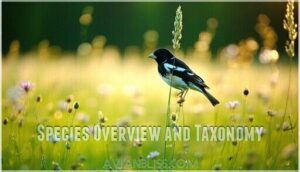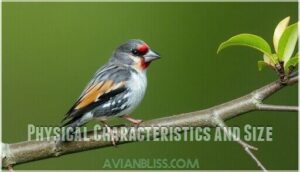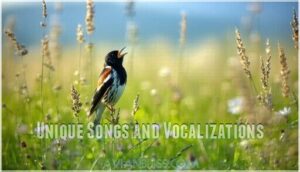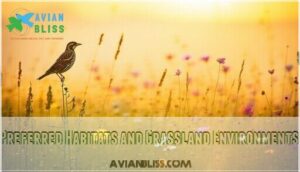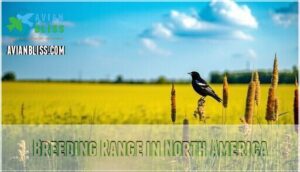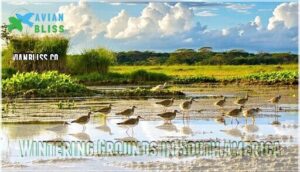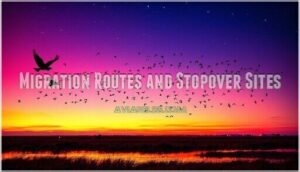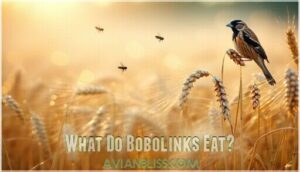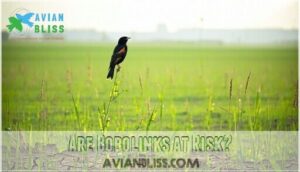This site is supported by our readers. We may earn a commission, at no cost to you, if you purchase through links.
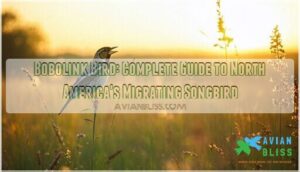
These marathon migrants travel an astounding 12,500 miles between North American prairies and South American grasslands, making one of nature’s longest songbird journeys. Don’t let their cheerful demeanor fool you – bobolink populations have plummeted 60% since 1966 as farms and development swallow their native habitat.
The story behind their decline reveals surprising connections between your breakfast cereal and bird conservation.
Table Of Contents
Key Takeaways
- Bobolinks are exceptional long-distance migrants – These robin-sized songbirds travel an astounding 12,500 miles annually between North American breeding grounds and South American wintering areas, making one of nature’s longest songbird journeys.
- Males display striking "backwards tuxedo" plumage – During the breeding season, males wear jet-black underparts with bright white patches above and golden-yellow napes, completely opposite to typical bird coloration patterns.
- Populations have declined dramatically due to habitat loss – Bobolink numbers have plummeted by 60% since 1966 as agricultural intensification and early hay harvests destroy their grassland nesting sites before young can fledge.
- They switch between insect and seed diets seasonally – Bobolinks consume protein-rich insects like beetles and caterpillars during breeding, then shift to grain-heavy diets during migration and winter, earning nicknames like "ricebirds" in agricultural areas.
What is a Bobolink Bird?
The Bobolink is a robin-sized songbird that belongs to the blackbird family, known for its striking black-and-white breeding plumage in males and its bubbling, musical song that sounds like "bob-o-link."
You’ll recognize this migratory species by its sharply pointed bill, flat head, and the male’s unmistakable spring appearance with black underparts and white patches on the back.
Species Overview and Taxonomy
Within the blackbird family Icteridae, you’ll find the bobolink (Dolichonyx oryzivorus) standing alone as the sole member of its genus. This evolutionary distinction makes it a unique branch in avian species classification. Carl Linnaeus first described this bird in 1758, establishing its taxonomic history through genetic analysis and morphological studies. Bobolinks are declining due to habitat destruction, impacting their populations.
Key taxonomic features include:
- Species Distinction: Only North American bird darker below than above during breeding
- Bobolink Classification: Monotypic species with no recognized subspecies
- Evolutionary Biology: Ancient Greek genus name meaning "long claw"
- Bird Identification Guide: Rice-eating species name reflects dietary behavior
Physical Characteristics and Size
Picture a robin-sized bird that punches way above its weight class in terms of endurance—Bobolinks might look modest at 6-8 inches long, but they’re built like tiny long-distance athletes. Their measurements tell the story of notable adaptability.
| Characteristic | Male | Female |
|---|---|---|
| Length | 6-8.3 inches | 6-8.3 inches |
| Wingspan | 10.6 inches | 10.6 inches |
| Weight | 1-2 oz | 1-2 oz |
| Agility Rating | 82/100 | 82/100 |
You’ll notice their strength endurance rating hits an impressive 95, reflecting exceptional stamina for those epic migrations. Size comparison puts them between Field Sparrows and Red-winged Blackbirds.
Their bobolink characteristics include that distinctive pointed bill and compact build. Color variations shift dramatically through plumage molting seasons, but their size and shape remain consistent—built for the long haul.
Male Vs. Female Plumage Differences
If you’ve ever seen a male bobolink in spring, you’d swear someone flipped nature’s color palette upside down. His breeding plumage breaks every songbird rule—jet black below, bright white patches above, and a golden-yellow nape that catches sunlight like spun gold.
Females wear streaky brown feathers that blend perfectly into grasslands, keeping them safe on the nest.
Come late summer, molting patterns transform males into the same cryptic brown as their mates, making bobolink identification tricky until next spring’s seasonal changes reveal those striking color variations again.
Unique Songs and Vocalizations
Nothing quite captures the essence of summer grasslands like the bubbling, liquid notes of a bobolink’s song cascading across open meadows. These striking vocalizations showcase impressive song complexity that sets them apart from other songbirds.
Here are four key aspects of bobolink vocalization:
- Flight song delivery – Males perform elaborate aerial displays while singing
- Song development varies among individuals through learned patterns
- Regional dialects emerge across different breeding populations
- Song functions include territory defense and mate attraction
Bobolinks also show remarkable talent for mimicking other birds’ calls and sounds.
Where Do Bobolinks Live?
Bobolinks break free from the typical songbird mold, roaming vast distances across two continents in their quest for the perfect grassland home.
You’ll find these nomadic musicians breeding in North America’s meadows and prairies, then embarking on an epic journey to South American wintering grounds that spans thousands of miles.
Preferred Habitats and Grassland Environments
You won’t find bobolinks perched on backyard feeders or city park benches—these grassland specialists need wide open spaces where tall grass sways in the breeze. They thrive in dense meadows and fields spanning at least five acres, where habitat fragmentation hasn’t carved up their world into unusable fragments.
| Habitat Type | Key Features |
|---|---|
| Native Grasslands | Dense vegetation, minimal disturbance |
| Agricultural Fields | Hay meadows, grain crops |
| Wetland Habitats | Marsh edges, damp meadows |
| Prairie Remnants | Original grassland ecology intact |
These grassland bird habitat protection efforts focus on maintaining the expansive territories bobolinks demand for successful nesting and foraging.
Breeding Range in North America
Bobolinks nest across a surprisingly huge area, from southern Canada all the way down through the northern U.S. It’s one of the biggest grassland bird ranges in North America. You’ll spot these striking songbirds in four main areas:
- Prairie Provinces – Alberta, Saskatchewan, and Manitoba are bobolink hotspots
- Great Lakes Region – Minnesota, Wisconsin, and Michigan host thriving populations
- Northeast Corridor – New York, Vermont, and Maine keep steady numbers
- Agricultural Zones – Farm fields from Montana to Pennsylvania work perfectly for nesting
But here’s the thing – climate change and broken-up habitats are really messing with where these birds can spread and thrive.
Wintering Grounds in South America
While North Americans watch these birds disappear southward each fall, bobolinks begin one of the longest migrations in the bird world—a 12,500-mile journey that lands them in the grasslands of Argentina, Paraguay, and southern Brazil.
These South American habitats provide abundant rice and grain fields where wintering bobolinks switch to an almost entirely seed-based winter diet, earning them the nickname "butter birds" in Jamaica.
Migration Routes and Stopover Sites
Across nearly 12,000 miles annually, bobolinks execute one of North America’s most noteworthy migration patterns. Most western populations travel eastward before turning south along the Atlantic coast, creating a funnel effect through the southeastern United States.
Critical stopover habitats in coastal marshes and Venezuelan grasslands allow birds to molt and accumulate fat reserves essential for survival during their exceptional journey to South American wintering grounds. These birds navigate using Earth’s magnetic field and stars.
How Do Bobolinks Behave and Nest?
Bobolinks break free from solitary songbird stereotypes, living in flocks that move like waves across grasslands during most of the year.
Their nesting behavior reveals a fascinating mix of competition and cooperation—males arrive first to claim territories through elaborate flight displays, while females quietly weave ground nests hidden so well that finding one feels like discovering buried treasure.
Flocking and Social Structure
Like nomads of the sky, these black-and-white wanderers rarely travel alone, gathering in tight-knit groups that can number in the hundreds during migration. Their social learning helps younger birds master complex foraging techniques, while cooperative defense protects the flock from predators.
Key flocking behaviors include:
- Flock hierarchy – Experienced adults lead migratory flocking routes
- Group foraging – Birds share information about prime feeding spots
- Territorial behaviour – Males show aggressiveness when defending resources
Flying together like this gives them real protection during those long, dangerous journeys.
Courtship Displays and Mating Habits
When spring fever hits the grasslands, male bobolinks transform into feathered showoffs that would make any peacock jealous. They compete fiercely through elaborate flight displays, soaring skyward while belting out their bubbling songs.
This aggressive behavior establishes dominance and attracts multiple females—bobolinks practice polygyny, where successful males court several mates. Female choice drives the process as they evaluate territorial quality and male fitness before accepting advances.
Nest Placement and Construction
Hidden beneath thick prairie grass, female bobolinks turn nest-building into a masterclass of camouflage and stealth. They weave cup-shaped nests using available nest materials like grass stems and weed fibers, creating shallow depressions in dense vegetation.
These ground nesting birds employ striking camouflage techniques, positioning their ground nest where thick cover conceals the typical clutch size of five to seven eggs perfectly.
Parenting and Chick Development
Both parents throw themselves into raising their young with exceptional dedication, transforming from carefree songsters into tireless providers overnight. The female undertakes incubation of five to seven eggs for about eleven days while the male defends territory. Once nestlings hatch, both parents work around the clock delivering protein-rich insects.
- Nestling diet consists entirely of invertebrates like caterpillars and beetles for rapid growth
- Helper birds occasionally assist with feeding, though most pairs manage alone
- Parental roles shift as chicks mature – males increase hunting while females brood
- Chick fledging occurs after 8-14 days, with young leaving the nest still dependent on parents
What Do Bobolinks Eat?
Bobolinks break free from typical bird diets, shifting their eating habits like seasonal nomads following nature’s rhythm.
You’ll find these adaptable songbirds switching from protein-rich insects during breeding season to becoming grain specialists during migration and winter.
Diet During Breeding Season
You might think these grassland acrobats survive on seeds alone, but breeding season transforms bobolinks into surprisingly fierce insect hunters. Their protein needs skyrocket during nesting, driving intense insect consumption.
You’ll find them snatching beetles, grasshoppers, and caterpillars with surgical precision. They show strong larval preference, targeting nutrient-rich grubs. Spider intake and snail consumption round out their high-protein diet, fueling successful reproduction.
Insect and Seed Preferences
Bobolinks aren’t casual about their food choices—they’re like tiny gourmets with very specific tastes that change with the seasons. During breeding, insect proportions reach 85% of their diet, targeting protein-rich beetles, grasshoppers, and caterpillars.
Their seed diversity preferences include:
- Native grass seeds for sustained energy
- Weed seeds from foraging locations near nests
- Agricultural grains during migration stops
- Winter berries in tropical wintering grounds
This seedeating behavior shifts dramatically as grain consumption increases outside the breeding season.
Seasonal Diet Shifts and Foraging Strategies
A Bobolink’s appetite transforms dramatically as the seasons roll by, switching from protein-packed insect hunter to grain-gobbling nomad with the precision of a master chef changing menus.
During spring breeding, insects dominate their diet for essential protein. Summer brings seed availability as grasslands mature. Fall migration triggers complete dietary shifts toward granivorous feeding behavior, while winter berries supplement their South American menu.
Impact on Crops and Agriculture
Rice fields across the South once echoed with the nickname "ricebirds" – an indication of these songbirds’ ability to turn vast agricultural landscapes into their personal buffet.
While bobolinks consume significant grain quantities during migration, they’re not entirely agricultural pests. Their seedeating habits include weed seeds, providing natural pest control benefits.
However, concentrated flocks can cause notable rice field damage, particularly when crop selection aligns with their migration timing through ricefields and other grain-producing areas.
Are Bobolinks at Risk?
Bobolinks face serious conservation challenges as their populations have declined considerably in recent decades.
The main threats include widespread habitat loss from agricultural changes and the growing impacts of climate change on their breeding and wintering grounds.
Population Trends and Conservation Status
Unfortunately, the numbers tell a stark story. North American bobolink populations have plummeted by roughly 60% since 1966, with some regions experiencing even steeper drops—New Brunswick lost nearly 88% of its birds since the 1970s.
Despite this alarming population decline, the IUCN still lists bobolinks as "Least Concern" globally due to their wide range. However, regional variations paint a different picture, with several states now ranking them as vulnerable or imperiled.
Conservation efforts are underway to reverse these trends, though habitat loss remains the primary driver of decline.
Threats From Habitat Loss and Climate Change
Grassland birds today face serious challenges from multiple threats reshaping their world. Habitat loss from early and repeated hay harvests hits hardest, destroying nests before chicks can leave. Climate change makes things worse through:
- Agricultural intensification destroying ground-level nests through machinery
- Habitat fragmentation splitting breeding territories into unusable fragments
- Climate mismatches disrupting migration timing and resource availability
- Grazing impacts and wintering degradation of South American grasslands
These species are in real trouble. Without immediate grassland conservation efforts, we could lose them entirely.
Conservation Efforts and Habitat Protection
Three major conservation partnerships are reshaping bobolink recovery across North America. The Bobolink Project compensates farmers for delayed haying, protecting hundreds of grassland acres annually.
Policy initiatives like Ontario’s Threatened Species Act provide legal habitat protection, while recovery objectives target population stability at 85% of current levels within twenty years.
Habitat restoration projects focus on maintaining ideal grass cover percentages for successful nesting.
Interesting Facts and Cultural Significance
Long before GPS guided their epic journeys, these notable birds earned nicknames that tell stories of survival, wonder, and human fascination across two continents.
Southern farmers called them "ricebirds" due to flocks raiding grain fields during migration. Their bubbling song inspired the name "Bob o’ Lincoln," while Jamaicans dubbed them "butter birds" for their rich flavor.
This ricebird history reflects humanity’s complex relationship with these notable songbirds—admiring their folklore connections while sometimes viewing them as agricultural pests.
Frequently Asked Questions (FAQs)
What does Bobolink mean?
Ever wondered how a bird earned its name from what sounds like someone cheerfully calling out "Bob o’ Lincoln"?
The Bobolink’s name comes from its bubbling song’s crescendo notes that early listeners interpreted as "Bob-o-link" or "Bob o’ Lincoln," giving this striking songbird its distinctive moniker.
Where do bobolinks live?
Picture a bird that’s basically a feathered nomad, wandering from the Canadian prairies all the way down to Argentina’s grasslands in one of nature’s most epic road trips.
Bobolinks inhabit vast grasslands across North America during breeding season, then migrate thousands of miles to South American wetlands.
What is a bobolink bird?
When you spot a bird that looks like it’s wearing a tuxedo backwards, you’ve probably found North America’s most dapper migrant.
The Bobolink is a robin-sized songbird with striking black-and-white breeding plumage that makes bird identification easy during spring migrations.
What does a bobolink sound like?
You’ve never heard anything quite like a bobolink’s bubbling, tinkling song that sounds like someone pouring liquid music from a pitcher. Their song characteristics include rapid-fire notes that tumble over each other in joyous chaos.
- Complex melodies – Males weave intricate vocal variations during territorial displays
- "Bob-o-lincoln" calls – Their name comes from distinctive notes heard in song crescendos
- Mechanical chatters – Flight calls sound like metallic clicks during migration
- Season-specific sounds – Breeding songs differ dramatically from winter vocalizations
- Sound analysis reveals – Bobolink vocalization patterns help researchers track population health
What are some interesting facts about bobolinks?
Behind their sweet song lies a bird that pulls off one of nature’s most astonishing vanishing acts—disappearing completely from North America every winter only to reappear thousands of miles later. Here’s what makes these noteworthy songbirds truly fascinating:
The Great Name Game
You’ll hear them called everything but their real name. In the South, they earned "ricebird" for raiding rice fields during migration. Jamaicans know them as "butter birds" when flocks arrive fat from their journey. The name "bobolink" itself comes from their bubbling song that sounds like "Bob o’ Lincoln" to many listeners.
Master of Disguise
Males undergo complete plumage molting that transforms them from flashy tuxedo-wearing performers to streaky brown birds indistinguishable from females by late summer. It’s like watching Clark Kent become Superman in reverse.
Physical Prowess That’s Hard to Believe
The Definitive Road Trip
Their migration patterns read like an adventure novel. These birds don’t just fly south—they disappear into South American grasslands for months, traveling up to 12,500 miles annually. No other North American songbird covers such distances or spends winters so far from home.
Polygamous Players
Males arrive first at breeding grounds and immediately start collecting multiple mates through elaborate aerial displays. Meanwhile, females might hedge their bets with several partners. It’s a complex social system that would make reality TV producers jealous.
Their Bobolink bird characteristics include astonishing aerial prowess that lets them navigate vast distances with pinpoint accuracy. Their Bobolink behavior and diet shifts dramatically between seasons—from protein-packed insects during breeding to pure grain consumption during Bobolink migration patterns. The distinctive Bobolink vocalization and song functions as both territorial marker and mate attractor, with males performing aerial concerts that echo across grasslands.
What strikes me most about these birds is their adaptability rating of 88—they’ve learned to thrive in both unspoiled prairies and agricultural landscapes, though habitat loss remains their biggest challenge.
How did a bobolink get its name?
The name "bobolink" springs from the bird’s own jubilant song, mimicking the musical notes that sound like "Bob o’ Lincoln" at the crescendo of their melodic performance.
Early settlers interpreted these bobolink vocalizations as resembling human speech patterns, giving rise to this descriptive name that captures their distinctive song behavior perfectly.
Why are Bobolinks going extinct?
Bobolinks aren’t actually going extinct, but their populations have nosedived by more than 65% since the 1960s, putting them on a steep decline that has conservationists worried.
Habitat degradation and agricultural practices drive this alarming trend, with pesticide use and climate impacts creating migration challenges that threaten their conservation status.
Why is it called a Bobolink?
Listen closely to a male bobolink’s bubbling song in spring, and you’ll hear the musical notes that gave this bird its name—a rollicking "bob-o-link" that echoes across grasslands like nature’s own folk tune.
The name comes directly from song interpretation, mimicking the distinctive vocalizations that sound remarkably like "Bob o’ Lincoln" during their melodic crescendos.
How rare is a Bobolink?
Bobolinks aren’t quite rare yet, but they’re vanishing faster than most people realize—about half of the entire Bobolink population has been lost since 1970, making them one of North America’s most rapidly declining songbirds.
Grassland birds like bobolinks have experienced a 53-percent population reduction since 1970, earning them "Decreasing" status from the American Bird Conservancy.
Where are Bobolinks found?
If you’re trying to track down these black-and-white nomads, you’ll need to think like a grassland detective—Bobolinks don’t stick around one place for long.
These migration masters breed across grasslands from southern Canada through the northern United States, then vanish completely to South American wintering grounds each fall.
Conclusion
Like messengers carrying urgent news between distant kingdoms, the bobolink connects two vast continents through its impressive journey. These striking birds don’t just migrate—they weave together ecosystems spanning from Canadian prairies to Argentine grasslands.
These striking songbirds weave together ecosystems from Canadian prairies to Argentine grasslands through one of nature’s most epic migrations
Each bobolink represents nature’s resilience, yet their declining numbers warn us that grassland treasures slip away while we aren’t watching. Upholding conservation efforts means protecting both their breeding grounds and wintering habitats, guaranteeing future generations can witness their liquid songs cascading across open meadows.
- https://explorer.natureserve.org/Taxon/ELEMENT_GLOBAL.2.102736/Dolichonyx_oryzivorus
- https://en.wikipedia.org/wiki/Bobolink
- https://vtecostudies.org/projects/grasslands/bobolink-research-and-conservation/bobolink-research/results/
- https://extapps.dec.ny.gov/fs/programs/dfw/SWAP2025/Birds/Bobolink.pdf
- https://www.allaboutbirds.org/guide/Bobolink/lifehistory

